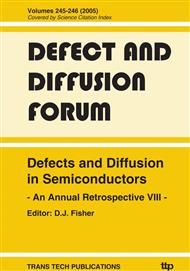p.1
p.9
p.15
p.23
p.29
p.39
p.51
DFT Analysis of the Indium-Antimony-Vacancy Cluster in Silicon
Abstract:
A cluster comprising of indium, antimony and a vacancy in silicon is analysed using the planewave pseudopotential technique. This cluster has a strong binding energy that inhibits indium diffusion after high temperature anneal cycles. Difficulties associated with the simulation of a vacancy using the supercell approach are initially highlighted. In comparison, the indium-antimony-vacancy cluster reveals stronger distortions and reduction in relaxation volume. The indium atom in the relaxed cluster shows nearly six-fold coordination whereas the antimony atom acquires four neighbours. Due to the low symmetry of the centre, in constrast to the isolated vacancy there is no propensity for a Jahn-Teller effect. It gives rise to two defect levels in the bandgap.
Info:
Periodical:
Pages:
29-38
Citation:
Online since:
October 2005
Authors:
Price:
Сopyright:
© 2005 Trans Tech Publications Ltd. All Rights Reserved
Share:
Citation:


